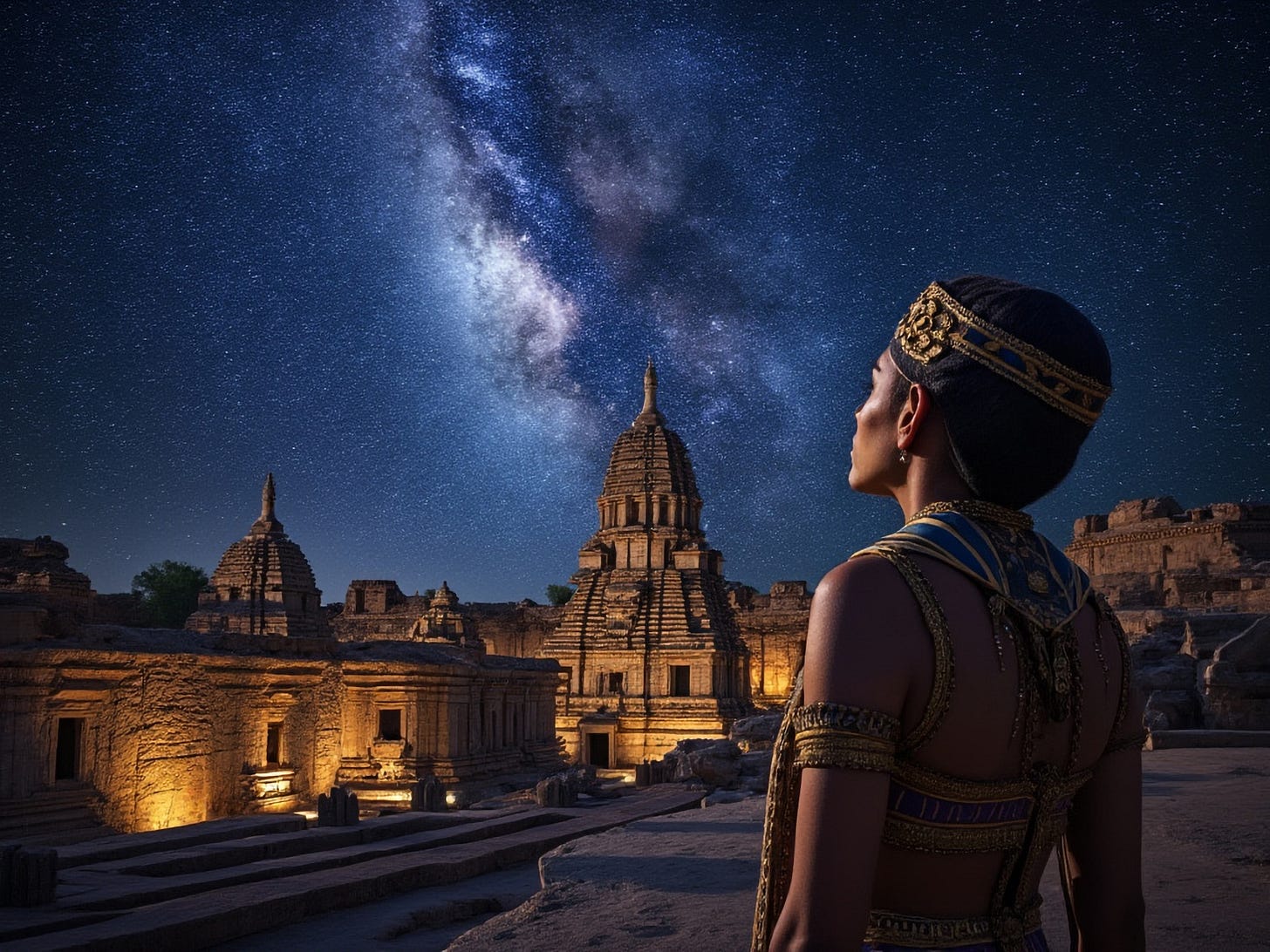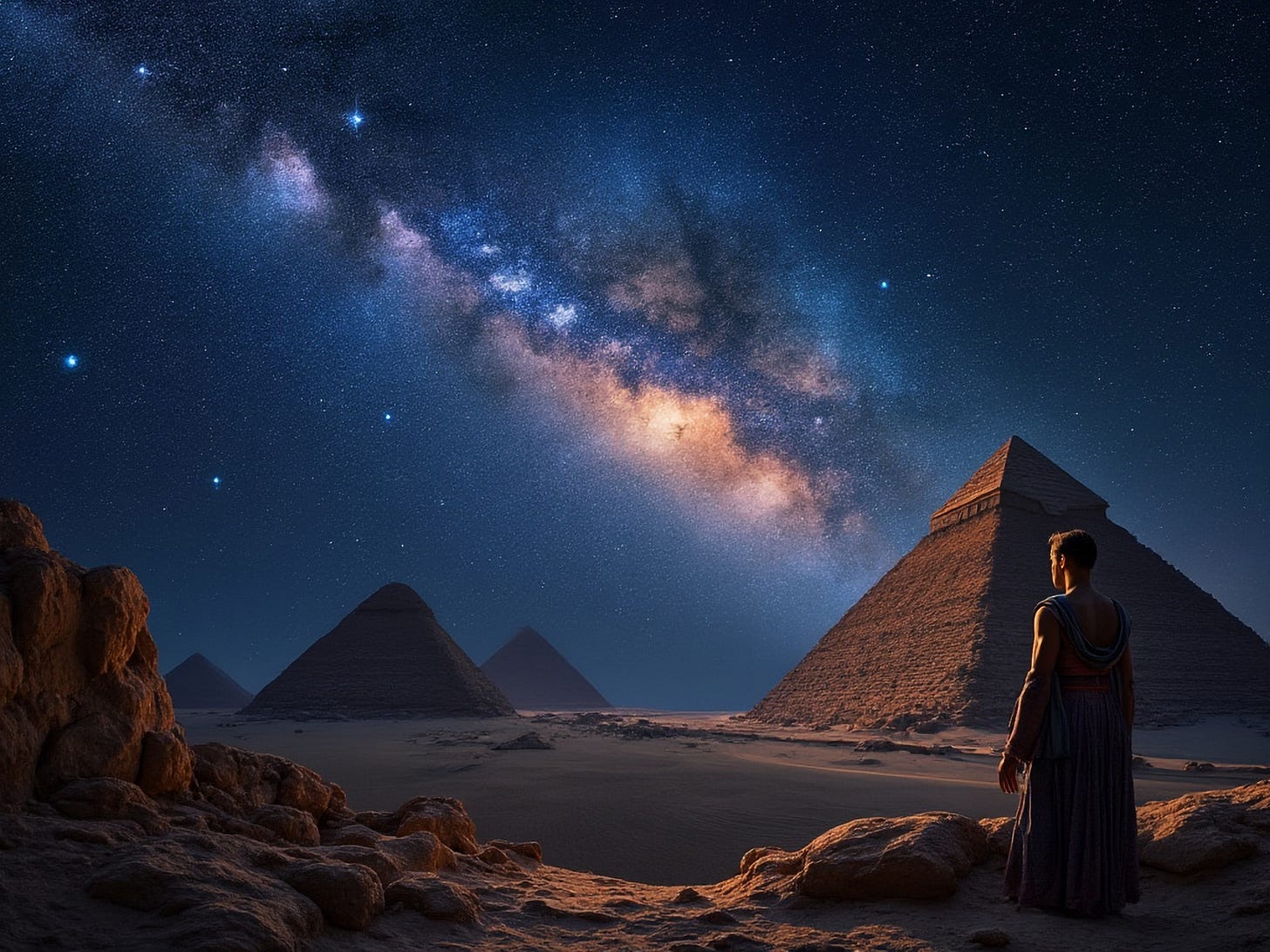The Path of Souls and the Journey Beyond Death
The Milky Way, with its glowing arms of stars stretching across the night sky, evokes the image of a luminous bridge connecting the realms of the living and the dead.
Throughout history, the night sky has inspired awe and mystery, urging humankind to seek answers about the nature of existence and the afterlife. Among the countless celestial wonders, the Milky Way has held a particularly sacred place in the mythologies and spiritual beliefs of many cultures across the world. Often perceived as a vast bridge of stars, the Milky Way has been seen as a "Path of Souls" – a cosmic highway where the soul embarks on its journey after death. This idea, deeply rooted in spiritual traditions, offers a poetic perspective on life, death, and what lies beyond.
The notion of a journey through the stars after death captures the imagination and provides a sense of continuity between the earthly and the divine. The Milky Way, with its glowing expanse stretching across the night sky, evokes the image of a luminous bridge connecting the realms of the living and the dead. This symbolism resonates with the human need to understand the mystery of what happens after life ends, to find solace in the belief that the soul continues its journey beyond the material world.
A Celestial Highway: The Milky Way in Ancient Beliefs
The concept of the Milky Way as the path to the afterlife can be found in various ancient cultures. In the traditions of some Native American tribes, the Milky Way is considered a sacred trail for souls traveling to the afterlife. The Lakota, Cherokee, and Chumash, among others, believed that the Milky Way marked the route that souls took to reach the spirit world, a place where they would reunite with their ancestors. The stars acted as guides, illuminating the journey of the deceased as they traversed the celestial path.
Similarly, the ancient Egyptians viewed the Milky Way as a celestial representation of the Nile River, which held great importance in their culture. To them, the river’s earthly counterpart was not only a source of life but also a symbol of death and rebirth. The Milky Way, seen as a reflection of the Nile in the sky, served as a path for the souls of the deceased to reach the realm of Osiris, the god of the afterlife. The journey along the Milky Way was one of transformation and rebirth, as the soul sought to reunite with the divine forces that governed the cosmos.
The Egyptians placed immense value on the afterlife, and their funerary practices were designed to ensure that the soul would successfully traverse the celestial realms. The Milky Way was believed to be a conduit through which the soul could ascend to the heavens, joining the stars and becoming part of the eternal cosmos. This belief was central to the Egyptian worldview, which emphasized the cyclical nature of life, death, and rebirth, with the Milky Way serving as a cosmic symbol of that cycle.
In Greek mythology, the Milky Way also carried significance related to the divine. According to one myth, the galaxy was created from the milk of the goddess Hera, spilling across the sky. For the Greeks, the stars were seen as a pathway that connected the mortal realm with the divine, a road that heroes and demigods might traverse on their quest for immortality. The Milky Way thus symbolized the link between the earthly and the divine, a bridge that connected human souls to the greater mysteries of the universe.
The Greeks believed that the soul's journey after death was fraught with challenges, and the Milky Way was viewed as a path that led to the realm of the gods. It was along this path that the souls of heroes, those who had achieved great deeds during their lifetimes, might find a place among the stars. The Milky Way, therefore, became a symbol of aspiration and transcendence, representing the possibility of immortality and the enduring legacy of one's actions.
The Path of Souls in Native American Spirituality
For many Native American cultures, the Milky Way was more than just a collection of stars; it was a sacred passage that represented the soul’s journey after death. The Cherokee, for instance, believed that the Milky Way was the "Road of the Departed," a path that souls took to reach the land of their ancestors. The stars acted as signposts, guiding the spirits along their journey, ensuring that they would not lose their way in the vastness of the cosmos.
The Lakota people also held a similar belief, viewing the Milky Way as the "Spirit Path." According to Lakota tradition, after death, the soul must travel along this path to reach Wakan Tanka, the Great Spirit. Along the way, the soul would encounter certain obstacles and tests, which would determine its fate in the afterlife. The journey along the Milky Way was not just a passage from one place to another; it was a transformative process, a rite of passage that allowed the soul to shed its earthly attachments and embrace its spiritual destiny.
The Lakota belief in the Spirit Path emphasized the idea that the soul's journey was a sacred trial, a test of its worthiness to enter the realm of the divine. The obstacles along the way were seen as necessary challenges that would purify the soul, enabling it to achieve spiritual enlightenment. The stars of the Milky Way served as guiding lights, illuminating the path and offering reassurance to the soul as it made its way toward the Great Spirit.
The Chumash, a Native American people from present-day California, saw the Milky Way as a bridge that connected the world of the living with the world of the dead. To them, the Milky Way was known as the "Sky Canoe," and it was believed that souls would travel along this celestial river to reach the afterlife. The journey was seen as a natural part of the cycle of life, death, and rebirth, a way for the soul to return to the cosmic source from which it had come.
The Chumash also believed that the Milky Way had a protective quality, ensuring that the soul's journey would be safe from malevolent forces. The celestial river was a sacred path that led the soul back to its origin, symbolizing the interconnectedness of all life and the continuity of existence. By viewing the Milky Way as a protective bridge, the Chumash found comfort in the belief that the journey after death was not undertaken alone but was supported by the very fabric of the universe.
The Milky Way as a Symbol of Transformation
Across cultures, the idea of the Milky Way as the "Path of Souls" serves as a powerful symbol of transformation. It represents the soul’s journey from the known to the unknown, from the physical world to the spiritual realm. The stars that make up the Milky Way are seen as beacons, guiding the soul through the darkness of the universe, offering hope and illumination in the face of the great mystery of death.
This concept of a celestial journey resonates with the universal human desire to find meaning in the face of mortality. The idea that the soul embarks on a journey through the stars after death offers comfort and a sense of continuity. It suggests that death is not an end but a transition, a passage from one state of being to another. The Milky Way, with its endless stretch of stars, becomes a metaphor for the soul’s eternal journey, a reminder that we are all part of something greater than ourselves.
The Milky Way's symbolism as a path of transformation also reflects the cyclical nature of existence. Life, death, and rebirth are interconnected, and the Milky Way serves as a reminder of this eternal cycle. The stars, ever-present in the night sky, offer a sense of permanence and stability, even as they symbolize the soul's journey into the unknown. The journey along the Milky Way is not just about leaving the physical world behind; it is about embracing the mystery of what lies beyond, finding solace in the idea that the soul is never truly lost but is instead part of a greater cosmic dance.
Modern Reflections on the Path of Souls
Even in modern times, the imagery of the Milky Way as a path for souls continues to inspire and captivate. The notion that our galaxy is a cosmic highway for the departed speaks to a deep-seated belief in the interconnectedness of all things. It reminds us that life and death are not opposites but are part of the same cosmic cycle, a dance of energy that continues endlessly.
In a world that often feels disconnected from the mysteries of the universe, the idea of the Milky Way as the "Path of Souls" invites us to look up at the night sky and remember our place in the cosmos. It encourages us to see the stars not just as distant balls of gas but as symbols of hope, guidance, and the eternal journey of the soul. Whether we view it through the lens of ancient mythology or modern spirituality, the Milky Way continues to be a source of wonder, a reminder that, even in death, we are never truly alone.
The modern fascination with the Milky Way as a symbol of the afterlife also reflects a broader yearning for connection with the cosmos. In an age dominated by technology and scientific advancement, the stars offer a reminder of the mysteries that remain beyond our understanding. The Milky Way, as a celestial path, speaks to the timeless human desire to find meaning in the vastness of the universe, to believe that our existence is part of something greater and more profound than we can comprehend.
The imagery of the Milky Way as a "Path of Souls" also finds expression in contemporary art, literature, and spiritual practices. Artists and writers often draw on this symbolism to explore themes of death, transformation, and the afterlife, using the galaxy as a metaphor for the soul's journey. In spiritual practices, the Milky Way serves as a visual reminder of the interconnectedness of all life, encouraging individuals to see their own lives as part of the greater cosmic whole.
Conclusion
The Milky Way, as the "Path of Souls," offers a beautiful and profound perspective on the journey of the soul after death. It is a reminder that the universe is full of mysteries beyond our comprehension, and that death, rather than being an end, is a journey toward the unknown. Across cultures and generations, the stars of the Milky Way have served as guides, illuminating the path that lies ahead, offering hope and comfort to those who look up at the night sky and wonder what awaits beyond this life. In the vast expanse of the cosmos, the Milky Way stands as a symbol of the soul’s eternal journey, a path that connects the earthly with the divine, the living with the departed, and the self with the infinite.
As we gaze at the Milky Way, we are reminded that our lives are part of a greater cosmic story, one that has been told for millennia and will continue to be told long after we are gone. The stars, shining brightly in the darkness, offer a sense of hope and continuity, a reminder that the journey of the soul is one of transformation, growth, and return. The Milky Way, as the Path of Souls, invites us to embrace the mysteries of existence, to find comfort in the idea that death is not an end but a continuation of the journey, a passage into the infinite, where the soul becomes one with the cosmos, forever traveling among the stars.





